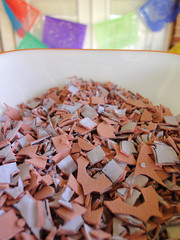My son and I dressed up in our new outfits from 1918 for a fashion show benefiting Chestnut Square this weekend. I'll try to post more about my full outfit later in the week, but I wanted to start with a little post about my hat.
I had originally planned on making something using proper millinery techniques, but as usual, I ran out of time and had to settle for my more typical methods of "hot glue a bit of luck". So off I went to Party City to pick up another $5 straw hat to reshape. You can see the hat in its original (and horribly ugly!) shape here.
Like many other cheap straw party hats, this one is made of a woven blank that can be shaped however you want vs. a hat made with straw coils that is stitched into it's shape. It is like a pair of Chinese handcuffs - if you push down on it, it gets wider, and if you pull on it, it gets narrower. This is very convenient when you are trying to reshape the crown into one of the large 1910's styles.

To reshape a hat of this type, all you have to do it wet it, and then hold it in the shape you want while it dries overnight. I wanted to make my crown shaped like a flared top hat, which is a style that shows up quite often in 1918. I squeezed the middle with my hands (which also made the hat taller), then wrapped some hair bands around the middle to hold it like that. I flattened the top just by stretching and pinching the edges. The brim had a tendency to flip up, so I weighted it down with random bottles that I had in my bathroom. As you can see, no high-tech tools are needed for this technique! :)

I was inspired by a variety of images from my 1918 New Idea Quarterly for the overall shape and decorations on my hat. The first picture shows the hat that was actually worn with the dress that I based my own outfit on. Although I changed the shape and decorations some, I decided to at least remain faithful to the color scheme of the original, so I used black velvet for the top of the hat and a lighter mauve wool that coordinated with my dress for the lining of the brim. The second illustration shows a hat with a narrower brim and the flared crown that is more similar to the overall shape of my hat. The third hat has a crown covered with pleated fabric, which gave me the idea of covering mine with a similar technique. The picture on the far right has a narrow hatband halfway up the crown at the smallest part of the flare, which I decided to use as well. So although my own hat isn't a direct copy of one particular style, I tried to capture the feel of 1918 millinery by combining a variety of elements from these different illustrations.
To cover the hat with fabric, I traced around the various parts of the hat directly on the material, cut it out (plus a little extra for wiggle room), used spray basting adhesive to stick it to the straw base, then finished the edges with hot glue on the parts you can't see and a strip of bias edging around the brim. Forgive me for glossing over the fabric steps, but it was 2:00 in the morning when I was working on it, and taking step-by-step pictures was very low on my priority list at that time. I also took some shortcuts which resulted in the annoying wrinkles on the top of the brim. I skipped the spray adhesive on that section, which I regret now. I could definitely do better with some more time, but sometimes "good enough" is good enough, if you know what I mean. Luckily, I'm tall, so maybe most people won't see that part of the hat very often. ;)

Covering the flared part of the crown with a flat piece of fabric would have been more tricky, but still doable with a bias cut strip, more spray adhesive, and a bit of luck. But I decided to avoid all that fiddly work by covering the rise of the crown with a 5" wide pleated silk moire ribbon that has been burning a hole in my stash for the past few years. I wanted to be able to remove the ribbon if I ever decided to use it for something else, so I skipped the hot glue this time and hand-tacked it to some grosgrain ribbon, then I simply tied the narrow ribbon into a bow to hold it all on the hat. A few more hand tacks at the bottom of the pleats hold the ribbon to the crown so it won't shift around. If you don't happen to have a bunch of 5" wide vintage ribbon burning a hole in your stash, you could also do the same thing with a long strip of fabric.
And that's it! Total time for making this hat = 2 hours. Cost of materials = around $20. The thrill of having a big crazy hat to finish off your 1910's outfit = priceless.






